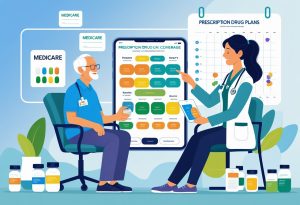Navigating Medicare can be complex, especially when it comes to understanding out-of-pocket costs. These expenses can significantly impact your healthcare budget, and knowing what to expect is crucial. In 2025, the maximum out-of-pocket limit for Medicare Advantage plans is set at $9,350, but individual plans can vary, potentially offering lower limits.
At The Modern Medicare Agency, we help you understand these costs and find the coverage that best suits your needs. Our licensed agents are real people available for one-on-one consultations, ensuring you receive personalized assistance. You can trust us to identify Medicare packages that align with your specifications without hidden fees that can strain your budget.
Understanding your out-of-pocket costs empowers you to make informed decisions about your healthcare. With the right information and support, you can navigate Medicare effectively and secure the best possible coverage.
Understanding Out-Of-Pocket Costs With Medicare
Navigating out-of-pocket costs with Medicare is essential for effective financial planning. You will encounter several types of shared costs associated with your healthcare. Understanding how these costs work can help you manage your expenses and make informed decisions.
Definition of Out-Of-Pocket Costs
Out-of-pocket costs refer to any healthcare expenses that are not covered by your Medicare plan. These expenses may include copayments, deductibles, and coinsurance that you are responsible for when receiving care. Each type of cost affects your total healthcare spending differently.
Medicare beneficiaries need to be aware of these costs to avoid unexpected financial burdens. Understanding your plan’s out-of-pocket limits and coverage specifics can help you budget accordingly.
Types of Shared Costs: Deductibles, Copayments, and Coinsurance
In Medicare, shared costs typically fall into three categories:
- Deductibles: This is the amount you pay for healthcare services before Medicare starts to pay. For 2025, the standard deductible for Medicare Part B is $185.
- Copayments (Copays): A copayment is a fixed amount you pay for a specific service or medication. For example, you might pay a copay every time you visit your doctor or fill a prescription.
- Coinsurance: This is a percentage of the costs you pay after meeting your deductible. For instance, if your plan has an 80/20 coinsurance split, Medicare covers 80% of the cost, and you cover the remaining 20%.
Understanding these costs will enable you to anticipate your financial responsibilities when accessing care.
How Cost-Sharing Works
Cost-sharing is a crucial concept in Medicare that determines how much you’ll pay for different services. When you receive care, each type of service may have its own cost-sharing structure based on your plan.
For example, Part A generally involves a deductible for inpatient stays, while Part B usually applies copayments for outpatient services.
Additionally, if you have a Medicare Advantage Plan, your cost-sharing may differ from Original Medicare. In this case, it’s important to review your plan documents to understand your specific cost-sharing details.
Factors Impacting Your Total Healthcare Costs
Several factors can influence your total healthcare expenses under Medicare:
- Plan Type: Your choice between Original Medicare and Medicare Advantage can result in varying out-of-pocket costs.
- Healthcare Usage: The frequency of doctor’s visits, hospital stays, or prescription medications will directly impact your expenses.
- Location: Healthcare costs can vary by geographic region, affecting your overall out-of-pocket limit.
- Health Condition: Chronic conditions or high medical needs may lead to higher costs due to ongoing treatments and medications.
By considering these factors, you can plan better for your potential out-of-pocket expenses. For personalized assistance, The Modern Medicare Agency offers licensed agents who can help you find the right Medicare package, tailored to your needs, without additional costs. You receive one-on-one support to navigate these complexities.
Original Medicare Out-Of-Pocket Expenses
Understanding the out-of-pocket costs associated with Original Medicare is essential for effective financial planning. This section focuses on the key expenses related to Medicare Part A and Part B, including premiums, deductibles, and additional costs for inpatient and outpatient care.
Medicare Part A Costs and Coverage
Medicare Part A primarily covers inpatient hospital stays, skilled nursing facilities, hospice care, and some home health services. While most people do not pay a premium for Part A if they have worked 10 years or more, there are still costs you need to consider.
Deductibles and Coinsurance:
- The deductible for each benefit period in 2025 is $1,600.
- After meeting your deductible, you will pay coinsurance of $400 per day for days 61-90 of hospitalization.
The lack of an out-of-pocket maximum means you can incur substantial costs for extended stays. Knowing these figures helps you budget effectively for potential hospitalization needs.
Part B Expenses: Premiums, Deductibles, and Coinsurance
Medicare Part B covers outpatient services, including doctor visits, preventive care, and diagnostic tests. You will be responsible for a monthly premium, which varies depending on your income level.
Key Costs Include:
- Average monthly premium is $164.90 in 2025.
- A deductible of $240 must be met before benefits kick in.
- After your deductible is met, you pay 20% of the Medicare-approved amount for most services.
These out-of-pocket costs can add up, especially if you require frequent medical services. Understanding these expenses is vital for managing your healthcare budget.
Inpatient Hospital Care and Benefit Periods
Inpatient hospital care under Medicare Part A is structured in benefit periods. A new benefit period begins the day you are admitted to a hospital or skilled nursing facility.
Costs depend on how long you are hospitalized:
- Days 1-60: You pay the full deductible ($1,600).
- Days 61-90: Coinsurance of $400 per day applies.
- Beyond 90 days: You can use your lifetime reserve days, paying $800 per day.
Navigating these costs efficiently can lead to significant savings during extended medical stays.
Outpatient Medical Care and Preventive Services
Medicare Part B encompasses a wide range of outpatient services. These include routine check-ups, vaccinations, screenings, and various therapies. Preventive services are often covered fully, provided you meet specific criteria.
Cost Structure:
- Annual wellness visit: Free of charge if you see a doctor who accepts Medicare.
- Screenings and vaccines: Typically have no out-of-pocket costs.
- For services that require coinsurance, expect to pay 20% after the deductible.
Regularly utilizing preventive services can help avoid larger healthcare costs in the future, promoting better overall health management.
For personalized guidance regarding these expenses, consider working with The Modern Medicare Agency. Our licensed agents offer one-on-one consultations to identify Medicare packages tailored to your specific needs, ensuring you won’t face unexpected fees that strain your budget.
Medicare Advantage Plans and Out-Of-Pocket Limits
Medicare Advantage Plans, also known as Part C, provide unique financial protections through yearly out-of-pocket limits. Understanding these limits can help you manage your healthcare expenses effectively.
Yearly Out-Of-Pocket Maximums for Part C
Each Medicare Advantage Plan has a maximum out-of-pocket limit (MOOP) that you must consider. For 2025, the annual MOOP varies, but it typically falls below $8,850 for in-network services, with many plans offering lower caps. This limit represents the most you will pay out-of-pocket for covered services in a year. In 2025, 30% of plans may offer a MOOP as low as $4,150, making certain plans a more affordable choice.
In-Network vs Out-Of-Network Services
Your costs can significantly differ based on whether you use in-network or out-of-network services. In-network services usually have lower co-pays and deductibles, and they count toward your out-of-pocket maximum. In contrast, out-of-network services may have higher costs and may not fully count toward the MOOP. Understanding each plan’s network is essential to minimize your healthcare spending.
What Counts Toward the Maximum Limit
Not every expense contributes to your out-of-pocket maximum in Medicare Advantage Plans. Generally, co-pays and deductibles for covered services apply, but some costs, like those for non-covered services or certain specialty drugs, do not. Expenses related to Part D (prescription drug coverage) also typically do not count toward your MOOP. Familiarizing yourself with these details is crucial for effective budgeting.
Choosing a Medicare Advantage Plan can be complex, but with The Modern Medicare Agency, you can navigate these options seamlessly. Our licensed agents will work closely with you to identify the best Medicare packages tailored to your needs, ensuring you maximize your benefits without incurring hidden costs.
Prescription Drug Coverage: Part D Out-Of-Pocket Costs
Understanding the out-of-pocket costs associated with Medicare Part D is crucial for managing your healthcare expenses. This section addresses key components like deductibles, copayments, and the phases of coverage that can impact your overall costs.
Part D Deductibles and Copayments
Medicare Part D plans often include deductibles, which are the amounts you must pay before your coverage starts. Many plans have a deductible that can range from $0 to $505 in 2025. After meeting this deductible, you typically pay a copayment or coinsurance for each prescription.
Copayments can vary based on the drug tier. For instance, generic drugs usually require lower copayments than brand-name medications. It’s essential to review your specific plan to understand your financial obligations for prescriptions. The Modern Medicare Agency can help you navigate these details without extra fees.
Donut Hole and Catastrophic Coverage
The “donut hole” refers to a gap in coverage where you may pay a higher percentage of your drug costs after reaching a certain limit, typically around $4,660 in 2025. During this phase, you are responsible for 25% of the cost of both brand-name and generic drugs.
Once your expenses exceed this threshold, you enter catastrophic coverage. Here, your out-of-pocket costs significantly decrease, and you pay just a small copayment for drugs for the remainder of the year. Understanding these phases can help you manage your costs effectively. Consulting with The Modern Medicare Agency’s licensed agents can assist in discovering the best plan fitting your specific needs.
Managing Costs With Medicare Supplement Plans
Medicare Supplement plans, commonly known as Medigap, play a crucial role in managing your healthcare costs. These plans help cover out-of-pocket expenses that Original Medicare does not, providing a safety net for unexpected medical bills.
How Medigap Assists With Shared Expenses
Medigap plans significantly alleviate the burden of shared expenses like deductibles, copayments, and coinsurance. As each plan offers various coverage levels, it’s important to choose one that fits your healthcare needs.
For instance, most Medigap plans cover the Part A coinsurance or hospital costs, along with a portion of the Part B coinsurance. This means you will pay less out-of-pocket when using medical services. The monthly premiums for Medigap vary based on factors such as your age and the specific plan you choose. Working with The Modern Medicare Agency ensures you find a plan that offers the best coverage at a competitive price.
Out-Of-Pocket Limits for Plan K and Plan L
Plan K and Plan L are unique among Medigap options due to their annual out-of-pocket limits.
- Plan K features a limit of $6,940 in 2025, while
- Plan L has a slightly lower threshold of $3,470.
Once you hit these limits, the plans completely cover your costs for the remainder of the year. This feature is particularly advantageous for those with high medical expenses, as it provides financial predictability. These plans still cover essential costs, but they typically have lower premiums compared to other Medigap options. Thus, knowing how much you might spend annually can facilitate better budgeting for healthcare costs.
Choosing Between Medigap and Medicare Advantage
Deciding between Medigap and Medicare Advantage can be a challenging task. While Medigap plans supplement Original Medicare, Medicare Advantage acts as an alternative to it.
If you prefer lower out-of-pocket costs and comprehensive coverage, Medigap may be the better option. Conversely, Medicare Advantage typically combines medical and prescription coverage, often featuring lower premiums but higher cost-sharing in some instances.
It’s vital to evaluate your healthcare usage patterns when making this choice. Consulting licensed agents at The Modern Medicare Agency provides personalized guidance tailored to your individual needs, ensuring you select a policy that aligns with your healthcare requirements without unexpected fees.
Frequently Asked Questions
Understanding out-of-pocket costs with Medicare is crucial for managing your healthcare expenses. Below are common queries that address how to navigate these costs effectively.
How can one calculate out-of-pocket costs with Medicare?
To calculate out-of-pocket costs, you’ll need to consider several factors, including premiums, deductibles, and copayments. These costs can vary between Original Medicare and Medicare Advantage plans. You can also use tools or consult with licensed agents to estimate potential expenses based on your expected healthcare needs.
What are typical out-of-pocket expenses that beneficiaries might incur under Medicare?
Beneficiaries often incur costs such as premiums for Part B, deductibles for services, copayments for doctor visits, and coinsurance for hospital stays. Additionally, certain services not covered by Medicare, like dental or vision care, can also contribute to your out-of-pocket expenses.
At age 65, what costs should one anticipate for Medicare coverage?
At age 65, you should anticipate costs like the monthly Part B premium and any supplemental premiums if you choose Medigap or a Medicare Advantage plan. Additionally, account for annual deductibles and any out-of-pocket costs related to your healthcare services.
Is there a maximum out-of-pocket limit for Medicare Part B enrollees?
Original Medicare does not have a maximum out-of-pocket limit for Part B enrollees. This means you are responsible for a percentage of costs for covered services after meeting your deductible. However, Medicare Advantage plans do typically impose a cap on out-of-pocket spending.
What expenses are applied toward the out-of-pocket maximum in Medicare Advantage plans?
In Medicare Advantage plans, costs like copayments for doctor visits, deductibles, and coinsurance for hospital care count toward the out-of-pocket maximum. This limit helps protect you from excessive spending in a given year.
How does the Medicare out-of-pocket maximum for prescription drugs work?
Starting in 2025, Medicare sets an out-of-pocket maximum of $2,000 for prescription drugs covered under Part D. Once you reach this threshold, your plan will cover 100% of the eligible drug costs for the remainder of the year.
For assistance in navigating these details, consider working with The Modern Medicare Agency. Our licensed agents prioritize your unique needs, helping you find the right Medicare package without unexpected fees.






